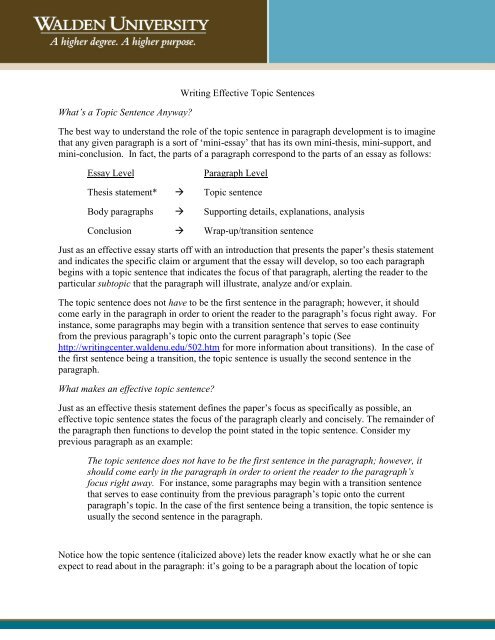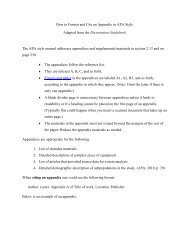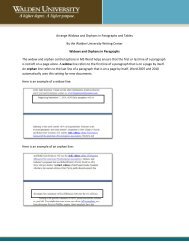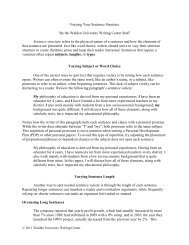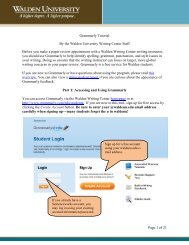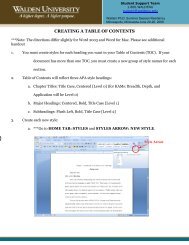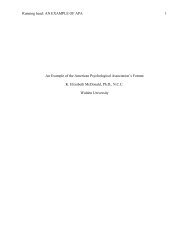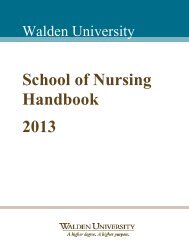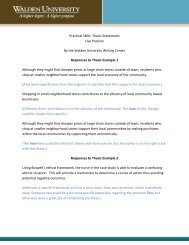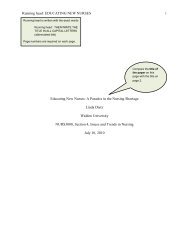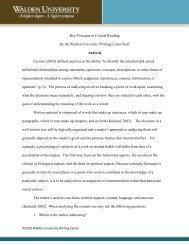Writing Effective Topic Sentences - Writing Center
Writing Effective Topic Sentences - Writing Center
Writing Effective Topic Sentences - Writing Center
Create successful ePaper yourself
Turn your PDF publications into a flip-book with our unique Google optimized e-Paper software.
What’s a <strong>Topic</strong> Sentence Anyway?<strong>Writing</strong> <strong>Effective</strong> <strong>Topic</strong> <strong>Sentences</strong>The best way to understand the role of the topic sentence in paragraph development is to imaginethat any given paragraph is a sort of ‘mini-essay’ that has its own mini-thesis, mini-support, andmini-conclusion. In fact, the parts of a paragraph correspond to the parts of an essay as follows:Essay LevelParagraph LevelThesis statement* <strong>Topic</strong> sentenceBody paragraphs Supporting details, explanations, analysisConclusion Wrap-up/transition sentenceJust as an effective essay starts off with an introduction that presents the paper’s thesis statementand indicates the specific claim or argument that the essay will develop, so too each paragraphbegins with a topic sentence that indicates the focus of that paragraph, alerting the reader to theparticular subtopic that the paragraph will illustrate, analyze and/or explain.The topic sentence does not have to be the first sentence in the paragraph; however, it shouldcome early in the paragraph in order to orient the reader to the paragraph’s focus right away. Forinstance, some paragraphs may begin with a transition sentence that serves to ease continuityfrom the previous paragraph’s topic onto the current paragraph’s topic (Seehttp://writingcenter.waldenu.edu/502.htm for more information about transitions). In the case ofthe first sentence being a transition, the topic sentence is usually the second sentence in theparagraph.What makes an effective topic sentence?Just as an effective thesis statement defines the paper’s focus as specifically as possible, aneffective topic sentence states the focus of the paragraph clearly and concisely. The remainder ofthe paragraph then functions to develop the point stated in the topic sentence. Consider myprevious paragraph as an example:The topic sentence does not have to be the first sentence in the paragraph; however, itshould come early in the paragraph in order to orient the reader to the paragraph’sfocus right away. For instance, some paragraphs may begin with a transition sentencethat serves to ease continuity from the previous paragraph’s topic onto the currentparagraph’s topic. In the case of the first sentence being a transition, the topic sentence isusually the second sentence in the paragraph.Notice how the topic sentence (italicized above) lets the reader know exactly what he or she canexpect to read about in the paragraph: it’s going to be a paragraph about the location of topic
sentences. Moreover, every sentence within the paragraph connects back to the topic sentencethrough illustration, explanation or analysis; every sentence in the sample paragraph tells ussomething about the placement of topic sentences.Although it may be tempting to begin a paragraph with a compelling quote, as a general ruletopic sentences should state the main idea of the paragraph in your own words. Direct quoteshave a place later in the paragraph where they may be incorporated to support the topicsentence’s point.Where can I get more information?If you are finding it challenging to create nice, focused topic sentences, you might consideroutlining before beginning to write a paper. The points and subpoints of an outline—especially ifyou put together a formal outline written in full sentences—can then become the topic sentencesfor the paper’s paragraphs. To learn more about full sentence outlines, see our out handout titledOutlining a Paper at http://writingcenter.edu/318.htm. To learn more about the thesis statement(the main point of the essay as stated in the essay’s introductory paragraph), see our ThesisConstruction handout at http://writingcenter.waldenu.edu/405.htm.


